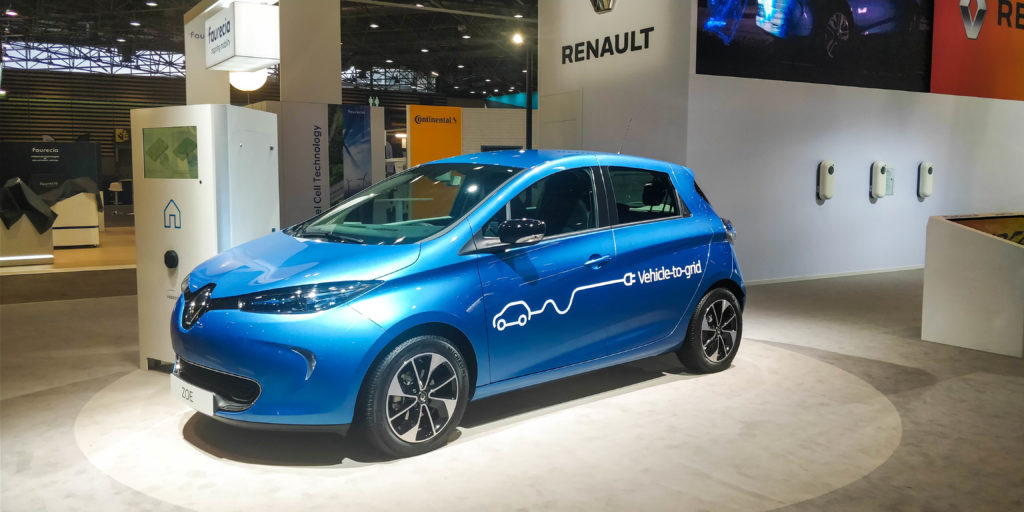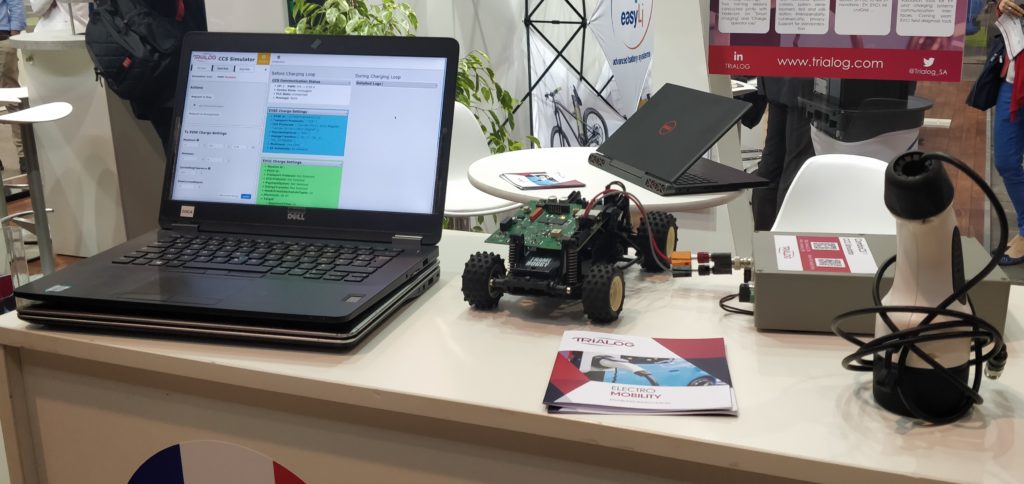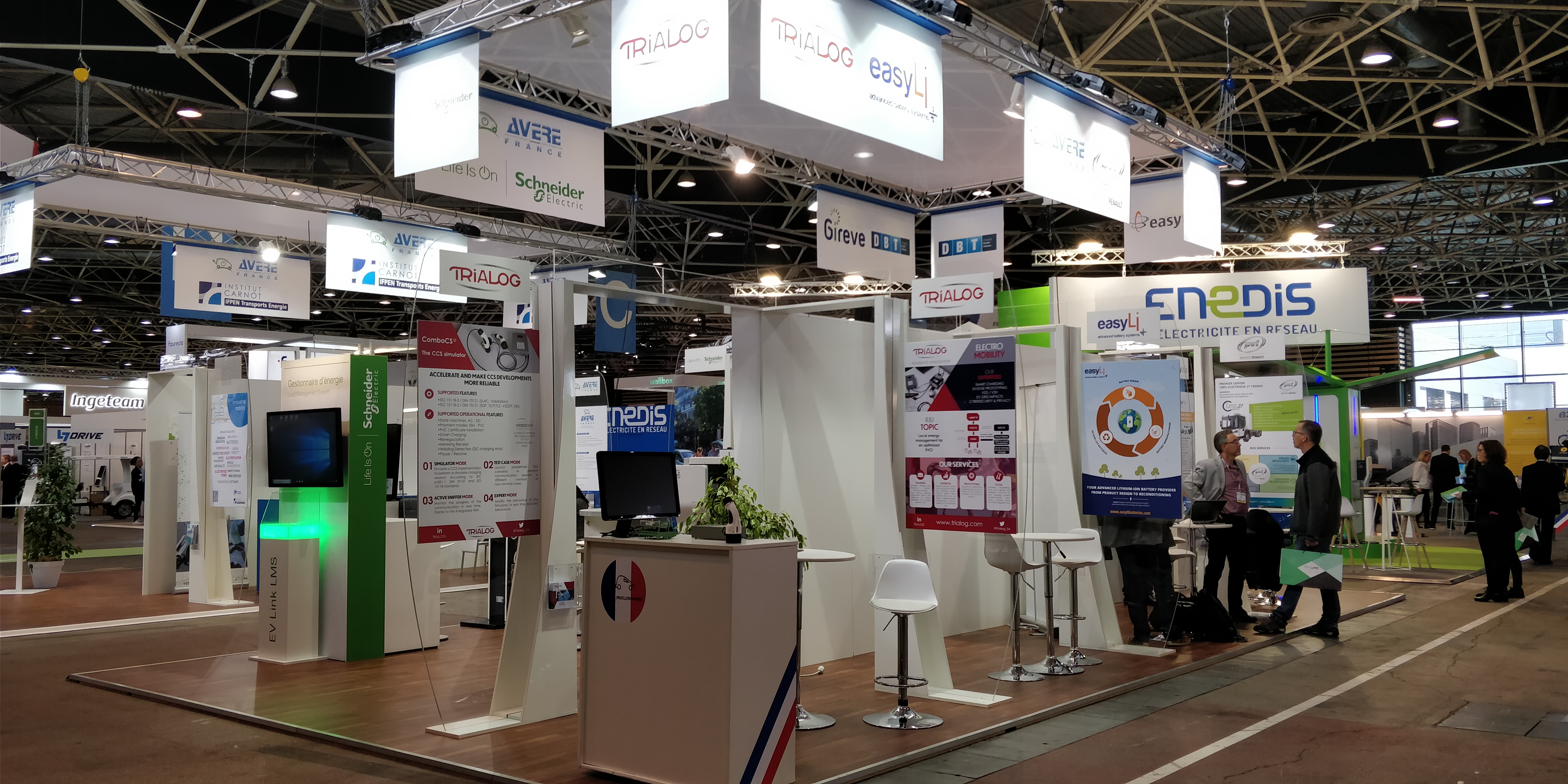A look back at the 32nd edition of the International Symposium on Electric Vehicles
The 32nd edition of the Electric Vehicle Symposium (EVS32), the annual meeting of electromobility ecosystem actors, was held in Lyon from 19 to 22 May, under the theme “A world of E-motion”. The EVS32 was structured around scientific and industrial conferences led by researchers and industrialists of the sector and an exhibition area dedicated to professionals from the ecosystem (car manufacturers, charging stations manufacturers, charging station and e-mobility services operators, electricity suppliers, etc.). Visitors were also able to test electric vehicles, in the ephemeral test area deployed for the event: the “Ride & Drive” area. TRIALOG participated to the promotion of the French expertise in the field, alongside many other exhibitors in the national pavilion. Its participation was an opportunity to present the results of its latest Research and Innovation results, in particular on the development of V2G (Vehicle to grid) and the Plug&Charge services defined by the ISO 15118 standard.
V2G technology in the spotlight
The mass deployment of the electric vehicle is sometimes considered as an additional constraint on the electricity grid (production, transmission and distribution) and sometimes as an opportunity for its balance, due to the possibility of modulating and scheduling power transfer levels when charging or even discharging the battery of the electric vehicle. The challenge of balancing the electricity grid is high, particularly with the mass introduction of renewable energies that are qualified as unavoidable because of their variability (depending on the wind power – wind turbine – and the degree of sunshine -PV-).
V2G technology was one of the main topics at the EVS32 scientific conferences. V2G can be considered as an adjustment variable in the balance of the private network in order to avoid exceeding the subscribed power, to optimize the energy bill, to improve the insertion of renewable energies, storage… In addition, it can also contribute to solving some constraints of the public distribution network or participating in system services. However, all this must not be done at the expense of guaranteeing the mobility needs of the vehicle user.
On the Renault stand, TRIALOG participated, alongside Renault and Vedecom, in the demonstration of a V2G use case combining PV production, V2G and energy flow management to optimize the house’s energy bill.

Plug&Charge: Simplify the user experience
The V2G was not the only innovation presented at the Renault Stand: the Plug&Charge was also on display. Plugging your vehicle without searching among your multiple authorization badges, while being assured that it will be charged in accordance with your mobility contract, this is the promise of Plug&Charge. Renault, Vedecom, Gireve, TOTAL EVCharge and TRIALOG have demonstrated that the solution, standardized by ISO 15118, is realistic.
The demonstration shows that the subscription to a Plug&Charge contract, the contract installation in the vehicle, the authorisation of the charge thanks to this contract and its revocation at the required time are very simplified operations from the end user point of view, even transparent and are based on the usual use of the recharge, all the complexity being absorbed by Renault’s, GIREVE’s and TOTAL EVCharge’s information systems, the charging station and the vehicle.
In addition to the simplicity and convenience provided by Plug&Charge, the advantage of such a solution is its interoperability. Unlike the other solutions presented at EVS32 (sometimes also called “Plug&Charge”), the demonstration is compatible with the ISO 15118 standard. From service perspective, the user is not linked to Renault or TOTAL EVCharge, he can use the same solution with other suppliers implementing the standard.
The ecosystem is being set up at European level, TRIALOG is fully engaged to work on interoperability of the different proposed offers and an independent governance of V2G PKI.
In this demonstration, TRIALOG provided its expertise on ISO 15118, Plug&Charge and the underlying PKI architecture. Otherwise, it is also its OCPP 2.0 stack that has been integrated into the charging station. TRIALOG is supporting OCA (Open Charge Alliance) for this new OCPP version, as it is, at the moment, the only standardized technical solution available to use the advantages of ISO 15118, including the Plug&Charge functionality.
Tooled engineering: simplify the development of ISO 15118 communication interfaces
At its booth, TRIALOG presented its new ISO 15118 charging point or electric vehicle simulation tool: “ComboCS“. With supporting demonstrations, the tool was warmly welcomed by visitors and as always, ISO 15118 raises questions (about use cases and technical choices) allowing interesting discussions.

ComboCS is the result of 10 years of TRIALOG experience in the smart charging. It is designed to support car and charging stations manufacturers in the development of their ISO 15118 communication interface. It mainly offers four operating modes:
- Simulator mode: allows to emulate the “Terminal” part of a CCS implementation to perform or simulate charging sessions according to IEC 61851-1, DIN 70121 and ISO 15118 standards.
- Scenario mode: allows to launch predefined test scenarios to perform communication sessions on different nominal or non-nominal cases.
- Active sniffer mode: allows to follow the evolution of the communication in real time, thanks to the integrated HMI.
- Expert mode: which offers the possibility to modify the behaviour of the Terminal in real time and test the behaviours.


